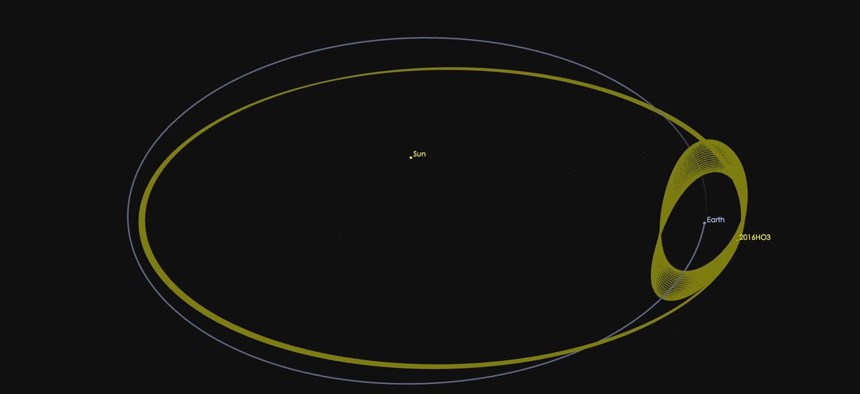NASA Finds That the Earth Has a New 'Mini Moon'
The quasi-satellite technically orbits around the sun but dances around the earth in the process.
An asteroid has been by Earth’s side for around 100 years—and it’s here to stay for a while longer.
Sized between 120 feet and 300 feet, the quasi-satellite named Asteroid 2016 HO3 was first discovered on April 27, 2016, by the Pan-STARRS 1 asteroid survey telescope in Hawaii. Nicknamed “mini moon,” the asteroid technically moves relative to the sun, but it seems to be playing around the earth’s orbit, too.
The rock has been doing a slow back-and-forth twist over decades. Half the time, its orbit takes it in front of the earth, closer to the sun. Other times, it jumps behind the earth, farther away from the star. “Its orbit is also tilted a little, causing it to bob up and then down once each year through Earth’s orbital plane. In effect, this small asteroid is caught in a game of leap frog with Earth that will last for hundreds of years,” NASA explains.
This rock is stable and poses no threat to our planet. The reason it is not considered an actual satellite, but a “quasi-satellite” is that it is too far from Earth—it doesn’t get much closer than about 38 times the distance of the moon. However, Earth’s gravity keeps tugging at it so it doesn’t wander astray either. “The asteroid’s loops around Earth drift a little ahead or behind from year to year, but when they drift too far forward or backward, Earth’s gravity is just strong enough to reverse the drift and hold onto the asteroid so that it never wanders farther away than about 100 times the distance of the moon,” said Paul Chodas, manager of NASA’s Center for Near-Earth Object. “In effect, this small asteroid is caught in a little dance with Earth.”
This isn’t the first time an asteroid has latched onto the earth’s orbit. Over 10 years ago, asteroid 2003 YN107 followed a similar orbital pattern for a much shorter time, and it has since left Earth’s vicinity. This mini moon seems to be a lot more committed to sticking around. “This new asteroid is much more locked onto us,” he said, predicting that “it will continue to follow this pattern as Earth’s companion for centuries to come.”



